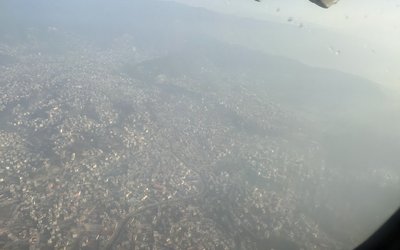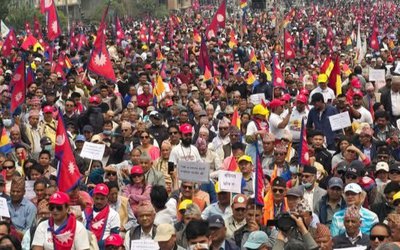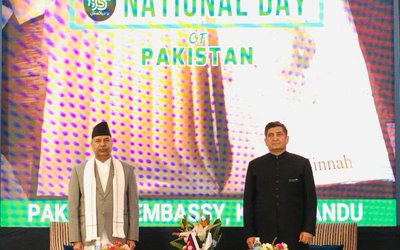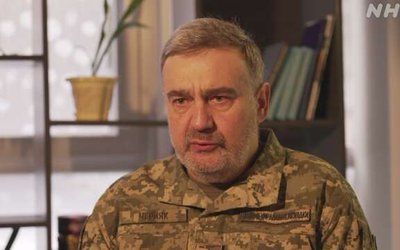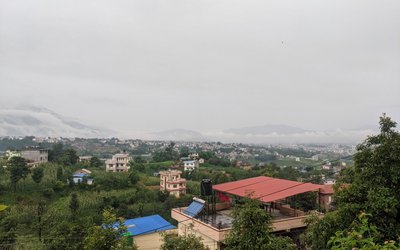
A rather sad element about contemporary debates over the size, structure, shape and utility of the Nepali Army; covered by the academia, press and social media; is that they frequently gather momentum after the announcement of a new budget year, or follow on the heels of a scandal or rising emotions. The cascade of undeveloped opinions devalues the significance of a vital concept and institution; that of national security and the Nepali Army.
Though pertinent, these views are largely defined by inaccuracies, given full reign by the woes of lackadaisical parliamentary oversight practices; bordering on negligence. This appalling display of obstreperous arguments by a coterie of representatives and analysts; tabled repeatedly to score publicity points; detracts focus from the core issue of analyzing the roles and missions assigned to the Nepali Army and assessing in detail its influence and sway in determining composition, size and structure.
Based on an objective evaluation of the current debates over the size and structure of the Nepali Army, it is evident that the fundamental issue is one of determining “Whether the Army is valuable national asset strength, or a wasteful financial burden a liability? This debatable issue carries significant portent for the future. In a recent survey of the Nepali people conducted by Kathmandu University and interdisciplinary analysts in 2022 CE, 91% of the respondents said, “The Nepali Army was the institution they trusted the most”. A response that implies it’s a valuable national asset, by/for the people. Additionally, in a recent retort to questions and statements aired by parliamentarians, regarding the efficacy of the force structure and composition of the Nepal is Army, the Deputy Prime Minister and Defense Minister in person retorted emphatically by reiterating its necessity in its current form and size; as a strategic imperative. Thus, the government and the people, two primary constituents of a nation state believe in the utility and necessity of the Nepali Army.
This brings us to the question of whether the current force is a burden. Peace and stability are prerequisites for development and progress. At present, Nepal is peaceful but to assert that we are stable is a stretch of the imagination. Alternately, from a financial perspective maintaining the current force structure and strength of the security forces i.e. the Civil Police and Armed Police and the defense force i.e. the Army is a strain on the national coffers, exacerbated by competing demands generated by social and economic sectors. This predicament cannot be overcome by knee-jerk actions. Regrettably, it is the flavor of the day.
The need of the day, however, is to conduct well-coordinated cross-cutting deliberations leading to comprehensive reviews of overarching government policies and processes; on governance and governing. Security being a basic need, as defined by its comprehensive nature will inevitably feature in all aspects of governance to a degree. Therefore, security concerns need to be tackled explicitly, by elevating its status to a priority sector on the national agenda. This would greatly enhance in formulating suitable plans, programs and budgets that steadfastly support government policies and people's aspirations.
The periodic outbursts of unschooled opinions unfairly undermine the credibility of a fine national institution and summarily consign numerous relevant concerns, raised by well-meaning individuals that require constant scrutiny, supervision and direction to the back burner. Providing structure, direction and guidance to debates over national security and the Nepali Army, to ascertain constructive outcomes, is an obligatory responsibility of the state. The means to deliver it is constitutionally mandated in the form of parliamentary oversight committees. Besides, the issue in hand is a simple one of energizing and reinforcing oversight measures by synchronizing and energizing the overall national security apparatus by means of injecting some energy and verve in it.
The quandary, of relentless pressure exerted by shallow controversies, casts a veil over more consequential issues. It contributes towards incapacitating a vital organ of the state, assigned with the role of safe guarding its sovereignty, territorial integrity and independence. It is a distressing state of affairs, particularly, in the context of a regionally contested and geopolitically fluid security environment, in the middle of a rapidly emerging multi-polar world order. Considering the centrality of the issue and its relative importance for the survivability of the state, this persistent malaise must be confronted squarely. Creating a separate parliamentary committee for National Security - Defense and Security by simply transferring current responsibilities held by the State Affairs Committee, is an effortless option. By doing so, the compulsion of elevating defense and security concerns on the national agenda is also fittingly addressed.
Taking into account the nascent and developing stage of strategic thought and planning, concerning the challenges posed by the 21st century, in our context; developing a common threat perception to guide our thought processes along least resistant lines, is of primary importance. Furthermore, clarity and comprehension of the concept of national power; its use and limitations; is necessary to weave diverse strands of logic and perceptions into a single piece of cloth. This endeavor leads to national consensus and pragmatic solutions; an essential criterion for national security strategy formulation. Without a doubt, it is a principled effort that will preserve the sanctity of a proud legacy handed down by our forefathers, whose Grand National strategy has kept Nepal afloat as a sovereign and independent nation over the centuries.
A foundational Weberian understanding; the threat of or use of force remains to be the monopoly and last resort of the state. It is, as a rule, entrenched in military organizations; with a police or armed police force as subsidiary additions to bolster national security, a concept that acknowledges the external and internal dimensions of national security. This arrangement essentially enables a graduated response from the state for the purpose of using force internally. However, this aspect of the state and statecraft in practice is often a source of constant-friction that provides sample room for divisive elements to exploit; as they feed on neglect and inadequate political commitment. This truth, further cements my argument for the state to shoulder the burden of responsibility to streamline the ongoing debates on a priority basis. It will inhibit ill-intention and ill-equipped security expert from parachuting in, to needlessly interfere and complicate matters. It also assists in guiding and moderating a sensitive issue along pragmatic lines to build national consensus; a statutory obligation.
Security is an abstract and unquantifiable concept that inhabits the domain of perceptions. Security threat perceptions are susceptible to rapid change; in the face of fear, pressure, intimidation, or coercion; which is a discernible feature in Nepal. Conversely, military organizations are large quantifiable entities, raised to provide and maintain security. They are built to withstand coercion, pressure and shock. Security levels though, are proportionately equivalent to the degree of threat posed which changes habitually. Therefore, presenting security environments as reason enough to downsize or augment force structures, is rather puerile, comparable to beating around the bush. All nations have dedicated organizations working in concert, to assess likely belligerent’s capabilities, threats and intentions. In our case, this exists in the form, of a constitutionally mandated National Security Council. A well-established, sufficiently manned and adequately resourced but defunct organization, it needs to be activated and mobilized in its visualized lead role, as the apex advisory and coordinating body of the state.
At this stage, we are without doubt on the horns of a dilemma, a dilemma of choices between ego-strategic gorge-economic imperatives and guns or butter, choices that will requires tradeoff between government spending on national defense and security and domestic programs. This predicament requires thorough analysis to enable sensible choices. The National Security Council should be tasked to undertake a comprehensive Strategic Defense and Security Review, for decision and necessary action by the government. Give it a catchy name or phraseology like SDSR 2023. Extensively publicize the undertaking intending to educate the public and promote transparency. Determine a realistic timeline for submission; unlike the timeline settled in the Interim Constitution 2007 for the integration of Maoist combatants and promulgation of a new constitution. As the saying goes, “A bird in the hand is better than two in the bush”. The bird is the NSC. This review must incorporate national debates to encourage wide participation driven by a preponderant axiom, “Effective defense and security do not come cheap”.
Therefore, taking all the factors discussed into account, it is reasonable to conclude that the Nepali Army is a valuable asset of the state, to be cherished and nourished to safeguard the nation against any and every existential threat. Though its utility may not be felt as it was during the Maoist insurgency; the comprehensive peace process remains unsettled, internal politics is still too complex and uncertain and it is untimely to put one's guard down. Moreover, all arguments aimed to rationalize the downsizing of the Nepali Army are premature at this point. Furthermore, military capabilities cannot be built overnight or purchased off the shelf asap. Any immediate decision to fiddle around with the composition and structure of the force is ill-advised and inopportune.
Determining the size, composition and capabilities of a military organization is incorporated in the force planning and force structuring modalities in practice. It is a process best left to the military professionals, under the direction and stewardship of the government. Factors ranging from an analysis of the threat, geography, technology, doctrine and resources required to organize essential battle operating systems, are considered to formulate various force options. They are subsequently, presented to the political leadership for decision and further action. From the outset, force planning is governed by the roles and missions mandated to the Army. Therefore, critical appraisals must focus doggedly on comprehending this aspect. There are two models of force planning and force structuring available to military planners, a threat-based and capability-based model respectively. Founded on experience, the later model is more compatible from all perspectives and has had a greater influence in determining the current force structure and strength. Therefore, selecting the capability-based model, to transform our force structure and develop capabilities to meet the security challenges of the 21st century is highly recommended.
Drawing examples, to validate down-sizing from comparisons between various Armies around the world, is a viable approach to critical thinking. However, it is important to anchor one's judgments on ground reality, based on a thorough understanding of restraints and constraints placed on planning by factors such as geography, size, population, economy, resources, etc. etera and the inherent limits of our composite national power. All criticism must be rooted in are cognition of what we have, and not based on what others have or hope we had. The ability to discriminate between what is possible and what is achievable, against what is desirable is indispensable, and so is the need to develop and apply the Means + Ways = Ends strategic framework; to devise sensible strategies that are successful in application and not only good looking on paper.
To conclude, rather than getting caught up in churlish banter over the size and strength of the Nepali Army, the crux of the deliberations must focus on understanding the basic structure, composition, capabilities and planning modalities of the existing force and its determinants. Organizations are created and structured to fulfill specific objectives. To do so, they are equipped with capabilities commensurate to their tasks. The entire process is determined by the threat, geography, natural resources, and technology and so on, underlined by an intangible factor “national prestige”.
The current foundational structure of the Nepali Army despite intense internal and political vacillation, has weathered the vagaries of time and change commendably. Transforming it into an effective and relevant force for the 21st century requires a major overhaul, a process that is a pipe dream given the current political and economic conditions. Therefore, restructuring and implementation of far reaching reforms, to build a springboard for subsequent transformation as visualized by the leadership, is the logical step ahead. Transformation entails time, money, commitment and a leap of faith; not just empty words and hollow promises.
The current situation in Nepal is a manifestation of unhealthy politics. Nepal has undergone tremendous political changes in a condensed time frame. Therefore, it is natural for inquiries to be directed pointedly at the military. However, a modicum of restraint in passing judgments is essential, as the military is only an instrument of the state and operates under the rubric of the government and the prevalent national security policies prescribed by it. The reform and transformation of the Nepali Army, in reality, is a long-haul task that requires national commitment and political will.
To my knowledge, only one Strategic Defense Review has been carried out in the Nepali Army between 1974 to 2015whichwas in 1978. This comprehensive internal review consisting of 14 files placed in a black briefcase called the “Black Box” was retained in the office of the Director of Military Operations (Plans & Policy). It laid the ground for the reorganization, modernization and doctrinal development of the Nepali Army until 1990.
Ever since, despite tectonic shifts in internal, regional and global politics the government has remained complacent in pursuing this primary obligation despite constant pleading and prodding. In light of the observations above, the complacency on display by a series of weak governments and the prevalence of a pessimistic view concerning the functions and capability of the Nepali Army among some parliamentarians; a long overdue Strategic Defense and Security Review is imperative to undertake without delay. As an afterthought such reviews as envisioned are resource intense and time-consuming endeavors that require a minimum of 4/5 years to prepare to be of any value.
General Rana is a Chief of Army Staff of Nepal Army (Retired)

